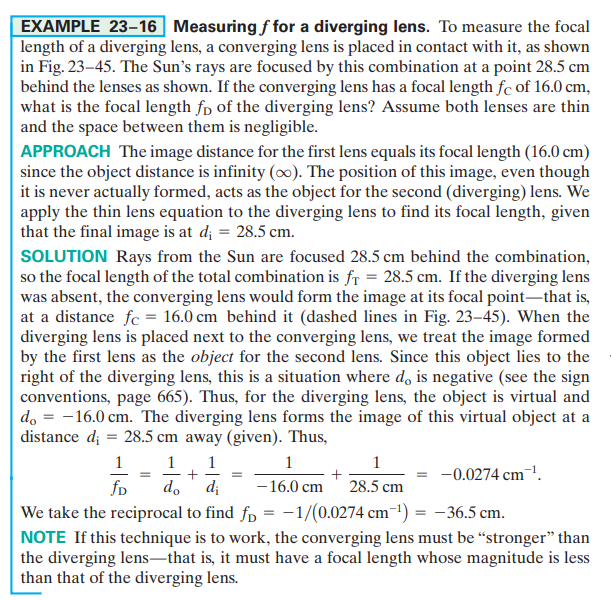EXAMPLE 23–16 Measuring f for a diverging lens. To measure the focal length of a diverging lens, a converging lens is placed in contact with it, as shown in Fig. 23–45. The Sun's rays are focused by this combination at a point 28.5 cm behind the lenses as shown. If the converging lens has a focal length fc of 16.0 cm, what is the focal length fp of the diverging lens? Assume both lenses are thin and the space between them is negligible. APPROACH The image distance for the first lens equals its focal length (16.0 cm) since the object distance is infinity (0). The position of this image, even though it is never actually formed, acts as the object for the second (diverging) lens. We apply the thin lens equation to the diverging lens to find its focal length, given that the final image is at d; = 28.5 cm. SOLUTION Rays from the Sun are focused 28.5 cm behind the combination, so the focal length of the total combination is fr = 28.5 cm. If the diverging lens was absent, the converging lens would form the image at its focal point–that is, at a distance fc = 16.0 cm behind it (dashed lines in Fig. 23–45). When the diverging lens is placed next to the converging lens, we treat the image formed by the first lens as the object for the second lens. Since this object lies to the right of the diverging lens, this is a situation where d, is negative (see the sign conventions, page 665). Thus, for the diverging lens, the object is virtual and do = -16.0 cm. The diverging lens forms the image of this virtual object at a distance d; = 28.5 cm away (given). Thus, 1 fD 1 1 1 1 + - do d; = -0.0274 cm!. + - 16.0 cm' 28.5 cm We take the reciprocal to find fp = -1/(0.0274 cm-1) = -36.5 cm. NOTE If this technique is to work, the converging lens must be “stronger" than the diverging lens-that is, it must have a focal length whose magnitude is less than that of the diverging lens.
Ray Optics
Optics is the study of light in the field of physics. It refers to the study and properties of light. Optical phenomena can be classified into three categories: ray optics, wave optics, and quantum optics. Geometrical optics, also known as ray optics, is an optics model that explains light propagation using rays. In an optical device, a ray is a direction along which light energy is transmitted from one point to another. Geometric optics assumes that waves (rays) move in straight lines before they reach a surface. When a ray collides with a surface, it can bounce back (reflect) or bend (refract), but it continues in a straight line. The laws of reflection and refraction are the fundamental laws of geometrical optics. Light is an electromagnetic wave with a wavelength that falls within the visible spectrum.
Converging Lens
Converging lens, also known as a convex lens, is thinner at the upper and lower edges and thicker at the center. The edges are curved outwards. This lens can converge a beam of parallel rays of light that is coming from outside and focus it on a point on the other side of the lens.
Plano-Convex Lens
To understand the topic well we will first break down the name of the topic, ‘Plano Convex lens’ into three separate words and look at them individually.
Lateral Magnification
In very simple terms, the same object can be viewed in enlarged versions of itself, which we call magnification. To rephrase, magnification is the ability to enlarge the image of an object without physically altering its dimensions and structure. This process is mainly done to get an even more detailed view of the object by scaling up the image. A lot of daily life examples for this can be the use of magnifying glasses, projectors, and microscopes in laboratories. This plays a vital role in the fields of research and development and to some extent even our daily lives; our daily activity of magnifying images and texts on our mobile screen for a better look is nothing other than magnification.
Example 23–16 shows how to use a converging lens to
measure the focal length of a diverging lens. (a) Why can’t
you measure the focal length of a diverging lens directly?
(b) It is said that for this to work, the converging lens must
be stronger than the diverging lens. What is meant by
“stronger,” and why is this statement true?

Trending now
This is a popular solution!
Step by step
Solved in 2 steps









